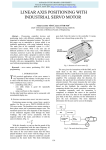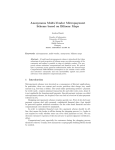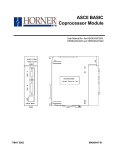Download MPT – GRE in UDP based Multipath Communication Library, User
Transcript
MPT – GRE in UDP based Multipath Communication Library, User Guide 2015.09.03. Project leader and main contact: dr. Béla Almási, [email protected], Faculty of Informatics, University of Debrecen, Debrecen, Hungary. Developers and members: dr. Márk Kósa, Ferenc Fejes, Róbert Katona, Tamás Kelemen, Levente Püsök Table of contents 1 Introduction .................................................................................................... 2 2 Using the MPT project ................................................................................... 3 2.1 Getting the latest distribution ................................................................. 3 2.2 Installing dependencies .......................................................................... 4 2.3 Extracting the tarballs ............................................................................ 4 2.4 Compiling the source code..................................................................... 4 2.5 The directory structure of the MPT environment .................................. 4 2.6 Editing the configuration files ............................................................... 5 2.6.1 Design topology ............................................................................. 5 2.6.2 The interface.conf file ........................................................ 6 2.6.3 Connections.................................................................................... 6 2.6.3.1 General configurations ............................................................... 7 2.6.3.2 Paths ........................................................................................... 9 2.6.3.3 Networks .................................................................................. 11 3 Running the MPT server .............................................................................. 12 4 Sending commands to the server ................................................................. 12 4.1 mpt address ................................................................................... 13 4.2 mpt interface .............................................................................. 13 4.3 mpt reload...................................................................................... 13 4.4 mpt delete...................................................................................... 14 4.5 mpt save .......................................................................................... 14 1 1 Introduction The current Internet communication environment allows the usage of a single path only for data transmission in a communication session: the endpoint of a communication session is identified by the IP address of the host’s interface (and the port number is also used inside the host for the identification). The single path assumption is quite acceptable for systems which use a single connection interface or a “single exit point” to the Internet. On the other hand, a lot of currently used devices have got factory built-in multiple network interfaces: RJ-45 for the wired network, RF interface for the Wi-Fi wireless network connection, and mobile phone data transfer connection interface (e.g., 3G, LTE, or HSPA). The single-path communication technology is not able to use the advantages of the multiple available interfaces. The communication performance (e.g., throughput, reliability) could be highly improved if the networking environment supported the usage of multiple paths inside a communication session. The term “connection” is used to refer to the communication session (or probably independent communication sessions) between two end hosts. The term “path” is used to refer to the pair of the network cards of the end nodes (identified by the pair of the cards’ IP addresses). Using a specified path, the packet transmission runs between the given pair of network cards. To put it simply, the multipath environment means that one connection is able to use multiple paths (multiple pair of IP addresses) for packet transmission. The IETF RFC 6824 “TCP Extensions for Multipath Operation with Multiple Addresses” (MPTCP, published in January of 2013) describes the necessary extensions for the TCP protocol in order to extend the current TCP implementations for supporting multiple paths. Actually, the MPTCP works in the transport layer and is restricted to the TCP protocol. Figure 1 – The MPT layered architecture The purpose of the MPT library is to open the possibility for the multipath environment in the network layer. The architecture of the MPT communication environment is based on the IETF RFC Draft “GRE in UDP” specification (which is currently a “work in progress” state specification), but the MPT environment allows the usage of multiple paths (see Figure 1). In this architecture, we distinguish the identification of the communication session’s endpoint (application’s socket) and the physical communication interface. In this mechanism, we create a logical (tunnel) 2 interface on the endpoints, which can be used by the applications for the socket identification. The IP packets transmitted to the tunnel interface by the application are encapsulated by the MPT software into a new “GRE in UDP” segment, which will be sent to the physical network interface for transmission. The MPT server (or MPT library) offers the possibility to map the packets (coming from the tunnel interface) to multiple physical interfaces dynamically, so offering the multipath communication for the application. There is no need to modify the application’s software in this case, as the application software uses only one single logical interface (the tunnel interface) for the communication. Also, the application may use the UDP transport protocol over the tunnel interface, it is not restricted to the TCP protocol. On the other hand, as the MPT library uses the UDP protocol in the encapsulation process, it will not offer retransmission and flow control services below the tunnel interface. Figure 2 – The PDU structure of the MPT-based communication The structure of the packet transmitted by the MPT environment can be seen in Figure 2. We have to mention that the fields of “Tunnel IP” and “IP” are absolutely independent, which means that also the IP versions can be different: it is possible to use IPv6 for the application (i.e., “Tunnel IP” will be IPv6) and to use IPv4 for the network interface (i.e., “IP” will be IPv4 in this case). Also, it is possible for the application to use IPv4 (i.e., “Tunnel IP” will be IPv4) and use IPv6 for the network interface (i.e., “IP” will be IPv6). Of course, the two versions can be the same. To use the MPT multipath communication environment, we have to configure and start the MPT server (see the next chapters of this document), and we have to use the tunnel interface for the application’s communication on both endpoints. 2 Using the MPT project 2.1 Getting the latest distribution To get the MPT [email protected]. environment, please contact the e-mail address The MPT software library was written in C in Linux. The project is delivered in various packages as described in Table 1. A package can contain the documentation, source code, and precompiled binaries. The mpt-gre-lib32 and mpt-gre-lib64 library packages were developed for Intel 386 and AMD x86-64 architectures. These distributions contain the user guide, the header files, the source code of the main program of the MPT server, and the compiled library files (libmpt.a, cli.a), which can be used to create the server (mptsrv) and the client (command line interface, mpt) executable. A simple example configuration is also given in the mpt-gre-lib32 and mpt-gre-lib64 distributions. The mpt-gre-src package contains the source code including the libraries’ sources, the user guide, the developer’s documentation, and the compiled libraries. 3 File name Docs Src Compiled library Executable mpt-gre-src-YYYY-MM-DD.tar.gz Yes Yes Yes No mpt-gre-lib32-YYYY-MM-DD.tar.gz Yes No Yes Yes mpt-gre-lib64-YYYY-MM-DD.tar.gz Yes No Yes Yes Table 1 – Tarballs 2.2 Installing dependencies The MPT server needs libc (GNU C Library, including pthread), make, gcc, iproute, openssl, tar, and gzip packages to be installed. The package names and its installation method can be different on the various Linux distributions and architectures. On Debian-based distributions, it can be installed with: # apt-get install libc6-dev make gcc gcc-multilib libssl-dev iproute tar gzip On Intel 386 and AMD x86-64 architectures, the package names may have different suffixes (e.g., for the Intel 386 architecture this suffix is :i386 , and for AMD x86-64 architecture this suffix is :amd). 2.3 Extracting the tarballs The package file contains a complete file structure under a subdirectory called mpt, which needs to be extracted. We recommend to put this folder into the /opt directory. To do that, use this command: $ tar xvzf PACKAGE_FILENAME –C /opt $ cd /opt/mpt/ 2.4 Compiling the source code On Intel 386 and AMD x86-64 architectures, the mpt and mptsrv can be rebuilt with the help of the precompiled libraries libmpt.a and cli.a, which can be found in mpt-gre-lib32 and mpt-gre-lib64 library packages. For this, you can use the following command: $ make You can build both 32-bit and 64-bit version of the programs, depending on the library package used: you have to use the mpt-gre-lib32 package or the mptgre-lib64 package, respectively. You have to be very careful when using these libraries because they use the -m32 and -m64 compiler options, which are only valid on Intel 386 and AMD x86-64 architectures. If you would like to build the server and the client program for other architectures, then you have to use the full source package. This package contains a Makefile that does not use -m32 and -m64 compiler options for building the programs. 2.5 The directory structure of the MPT environment Everything can be found in the mpt/ folder, every file and folder mentioned later is relative to that. 4 The binaries can be found in the root of the mpt/ folder. There is a server application called mptsrv and a client called mpt (see Chapter 3 and Chapter 4). The client application (i.e. the mpt command) can be used to modify the server working parameters (e.g. turn off or on a path usage in the system). In the bin/ directory, there are some scripts that are used by the MPT server to configure system settings (e.g., interface addresses, route table entries). The content of these command scripts can be changed without recompiling the source. In the conf/ directory, there are the configuration files (see Section 2.6). In the doc/ directory, the documentation that belongs to the selected package can be found. The src/ directory contains the source code. It is beyond the scope of this document to explain this in detail, please read the Developer Manual for further description. 2.6 Editing the configuration files 2.6.1 Design topology We will need the local and remote IP addresses of the MPT environment endpoints, and we will need to allocate two new IP addresses for the tunnel interface. Now, a sample configuration with two paths will be discussed. Figure 3 shows the IP address and port number assignments in this example. Figure 3 – A sample topology This document discusses the configuration files on host A, but the package files contain the configuration files for host A and host B too. In the studied example, we assume that the Ethernet cards of the hosts are directly connected to each other (i.e., eth1 of host A is directly connected to eth1 of host B; and eth2 of host A is directly connected to eth2 of host B). 5 2.6.2 The interface.conf file The tunnel interface and some general configuration setting can be found in the conf/interface.conf file. The configuration file is a standard ini file. Each line has a key and a value part. The name of the key indicates its functionality. The value is assigned to the key by using the equality (“=”) sign. Comment lines start with a “;” sign. [general] tunnel_num = ; Accept remote accept_remote = cmdport_local = cmd_timeout = 1 new connection request 1 60456 25 [tun_0] name = tun0 ipv4_addr = 10.0.0.2/24 ipv6_addr = fec0::2/64 Configuration 1 – A sample interface.conf file The file is made up of sections. The first section contains general information. Here, we configure how many tunnel and interface we want to handle by using the mpt software. The current version of mpt handles one tunnel interface, which must be declared. In the [general] section the accept_remote key indicates weather the software enables mptsrv to act like a server. If this parameter is set to 1, then clients can initiate creating new connections not defined in local configuration files. The server will accept control commands from remote sites (clients). The cmdport_local parameter sets the UDP port number which will be used to accept control commands. The cmd_timeout parameter sets the timeout value (in seconds) of the local client waiting for the server’s answer (i.e. the mpt command will wait cmd_timeout seconds for the answer of the server). Usually the server action takes several seconds, as the server must communicate the action to its peer. The section [tun_0] describes the tunnel interface parameters. The name key specifies the name of the tunnel interface, which is used by the operating system to access to the interface. The ipv4_addr and the ipv6_addr parameters set the IPv4 and IPv6 address (and prefix length) of the tunnel interface. The tunnel interface is created and configured by the mptsrv application automatically, no further interaction is required from the user. 2.6.3 Connections Connection configurations can be found in the conf/connections/ directory and must have .conf extension. An example configuration is shown in Configuration 2 based on the topology shown in Figure 3. 6 ########################## GENERAL INFORMATION ################### [connection] name = MPT_connection_10.0.0.2 permission = 3 ip_ver = 4 ip_local = 10.0.0.2 local_port = 23456 ip_remote = 10.0.0.3 remote_port = 23456 remote_cmd_port = 60456 path_count = 2 network_count = 2 status = 0 reorder_window = 0 max_buffdelay_msec = 200 auth_type = 0 auth_key = 0 ########################## PATHS ############################ [path_0] interface_name ip_ver public_ipaddr gw_ipaddr remote_ipaddr keepalive_time dead_time window_size status = = = = = = = = = eth1 4 10.1.1.2 10.1.1.2 10.1.1.3 5 11 1 0 [path_1] interface_name ip_ver public_ipaddr gw_ipaddr remote_ipaddr keepalive_time dead_time window_size status = = = = = = = = = eth2 4 10.2.2.2 10.2.2.2 10.2.2.3 5 11 1 0 ####################### NETWORKS ################################# [net_0] ip_ver = 4 src_addr = 11.1.1.0/24 dst_addr = 21.1.1.0/24 [net_1] ip_ver src_addr dst_addr = 4 = 12.1.1.0/24 = 22.1.1.0/24 Configuration 2 – A sample connection.conf file 2.6.3.1 General connection configuration – section [connection] The [connection] section contains the general description of a connection. Here is the list of the keys of the [connection] section: name (mandatory): The value is a word (without space) containing the unique name of the connection. If we use multiple connections, the name must uniquely identify the connection. 7 permission (mandatory): The permission key may have four possible values depending on what we want to permit to the program. There are SEND and RECEIVE permissions, which allow sending and receiving connection updates. The term “SEND” means that the local MPT environment is allowed to start configuration change to the peer. The term “RECEIVE” means that the peer is allowed to start a configuration change, and the local MPT environment will accept it. The interpretation of the values can be seen in Table 2. RECEIVE SEND VALUE - - 0 - + 1 + - 2 + + 3 Table 2 - Connection update ip_ver (mandatory): The key indicate the local and remote IP version of the connection (i.e. the IP version used by the tunnel interface). It can be either 4 or 6. ip_local (mandatory): The IP address of the tunnel interface. local_port (mandatory): A number between 1 and 65534. It refers to the GRE in UDP data port (which is not fixed yet by IANA). It must be an unused UDP port number. It is going to be used for sending and receiving data packets on any path. If it is not a unique unused port, the server will be unable to bind and will exit immediately. ip_remote (mandatory): The IP address of the tunnel interface of the remote peer. remote_port (mandatory): Similar to local_port, but it is used on the remote peer. It is going to be used as a target UDP port when sending data through the tunnel to the peer. remote_cmd_port (mandatory): The UDP port number of the peer, which is used to accept control commands. If we start an mpt command (e.g. turning off a path usage) the mptsrv server will communicate this action to the peer by using its remote_cmd_port as the destination port number. path_count (mandatory): The key is an integer p, denoting the number of paths defined for this connection. The minimum value is 1, the maximum value is 20. This configuration file must have p sections ([path_n]), where 0 ≤ 𝑛 < 𝑝, describing all paths of the connection. network_count (mandatory): The MPT environment can be used to establish tunnel between networks (i.e. not only the tunnel peers can use the tunnel for communication). The value must be chosen from the interval [0,20]. This key is an integer l, denoting the number of networks on which the actual connection is able to route. This configuration file must have l sections ([net_n]), where 0 ≤ 𝑛 < 𝑙, describing all networks that belong to the connection. status (mandatory): The key indicates the initial status of the connection. The value 0 means OK. reorder_window (optional): The MPT environment can be forced to ensure the right ordered packet transmission for the tunnel communication. As the delay of the 8 different paths can be different, packet reordering may appear in a packet sequence transmission. In this case the receiver uses a buffer-array to store the incoming (unordered) packets. Then the packets are sorted according to the GRE sequence numbers, so ensuring the ordered transmission to the receiver’s tunnel interface. The reorder_window value specifies the length (or size) of the buffer-array. The value of 0 (which is the default value when omitted the key) means, that no sorting will be performed at the receiver (the packets are transferred to the tunnel interface immediately when they arrive). The maximum value of the reorder_window parameter can be 10.000. max_buffdelay_msec (optional): This key is used only if we require ordered packet transmission (i.e. reorder_window > 0). If ordered packet transmission is required max_buffdelay_msec specifies the maximum time (in milliseconds) while the packet is stored in the buffer-array. If the packet is delayed in the buffer-array for the specified time it will be transmitted to the tunnel interface, even in the case, when some packets are missing before the considered packet. The missing packets are considered as lost packets (i.e. we will not wait more for a lost packet). The arrived packets are transferred to the tunnel interface according to their GRE sequence number, so the ordered delivery will be kept also in the case of packet loss. auth_type (mandatory): The MPT system uses control communication between the tunnel endpoint. The control communication can be requested to use authentication. The value 0 means no authentication. Other useable values can be found in Table 3. auth_key (optional): The auth_key contains the key value of the control communication authentication. Some algorithms do not need authentication keys. In this case the specification of the auth_key is not necessary, or will be ignored. The list of authentication algorithms and their keys required can be found in Table 3. AUTH. TYPE AUTH. KEY Algorithm name 0 No AUTH_NONE 1 No AUTH_RAND 2 Yes, 64 byte long in HEX AUTH_SHA256 Table 3 - Authentication types 2.6.3.2 Path configuration sections – [path_n] interface_name (mandatory): The value is the name of the physical interface used by the given path for packet forwarding (e.g. wlan0). ip_ver (mandatory): Specifies the version of IP used by the path. The value can be 4 or 6. public_ipaddr (mandatory): Specifies the public IP address of the interface used for the tunnel communication. If the host is placed into the Global Address Realm, the public_ipaddr is the IP address of the interface, otherwise (i.e. when the host is behind a NAT-Box) it is the public address assigned by the NAT-Box to the tunnel communication session. If the path uses IPv4 and NAT, then the special address value of “0.0.0.0” can be used to force the mptsrv program to determine the public IP address automatically. 9 private_ipaddr (optional): The IP address of the physical interface. Can be omitted, if the public_ipaddr is assigned directly to the interface. When using IPv4 and NAT the special value of “0.0.0.0” can be used to force the mptsrv application to read and use the first IPv4 address assigned to the interface. remote_ipaddr (mandatory): Indicates the public IP addresses of the remote endpoint. gateway_ipaddr (mandatory): The IP address of the gateway, used to reach the peer (i.e. remote_ipaddr) using the given path. keepalive_time (optional): The MPT system monitors the availability of each path by sending keepalive messages regularly. The key specifies the frequency (ie. the time between the keepalive messages in seconds) that mptsrv uses for sending keepalives. The value of zero (which is the default value) means switching off the keepalive mechanism. dead_time (optional): If the keepalive mechanism is active, and the host does not receive keepalive message on the given path from the peer for dead_time seconds then the path is considered as “dead” and will not be used for data transmission. The default value is 3*keepalive_time. weight_out (mandatory): This is the “weight of the path” in the system. The mptsrv program distributes the outgoing packets between the available paths according to their weighs. For example, if we have 3 paths with weights 12, 18, 15 then the “sending cycle” contains 45 packets (the sum of the weights). In each sending cycle each path will transmit packets according to the weight value. In our example the first path will transmit 12 packets, the second path will transmit 18, and the third one will transmit 15 packets in one sending cycle. The sequence of the paths in a sending cycle is optimized to perform the best approximation to the ratio of the weights at each timepoint inside a sending cycle. status (mandatory): This key means the initial state of the path after starting mptsrv. The value 0 means that the path is usable (working), and the state of the path is OK. 10 2.6.3.3 Network configuration section – [net_n] With configured networks in mptsrv, we are able to use the application as a router, routing the packets among several networks between the tunnel endpoint – establishing a multipath site-to-site connection. Figure 4 – A sample topology for networks ####################### NETWORKS ################################# [net_0] ip_ver = 4 src_addr = 11.1.1.0/24 dst_addr = 21.1.1.0/24 [net_1] ip_ver src_addr dst_addr = 4 = 12.1.1.0/24 = 22.1.1.0/24 Configuration 3 – The network part of a configuration file. Every section that belongs to a network configuration start with the “net_” prefix. In these sections the ip_ver key indicates the version of IP protocol used by the network. The src_addr describes the source network and its prefix length. Similarly, the dst_addr key describes the destination network and its prefix length. With these parameters, we are able to define a route between networks through the defined connection (i.e. we can establish a multipath connection between sites). The network configuration can also be used to provide multipath Internet connection by specifying 0.0.0.0/0 as destination address and prefix length. (The source is our tunnel address in this case.) 11 3 Running the MPT server For starting the MPT server, root privileges are necessary. (To obtain root privileges, the sudo command can be used.) To start the server, just type in: # ./mptsrv On successful startup, the output will be something like this: Tunnel information: Tunnel interface : tun0 Tunnel device : /dev/net/tun Tunnel file desc.: 4 Tunnel ipv4 addr.: 10.0.0.2/24 Tunnel ipv6 addr.: fec0::2/64 CMD server port number : 60456 CMD client port number : 52242 Global server : 0 If the start was not successful (e.g., root privileges are missing), an error message will be given, for example: Tunnel interface IOCTL error. Errno: 77 After the MPT server started, we can check in other terminal windows, whether the tunnel interface was successfully created. # ip addr [...] 5: tun0: <POINTOPOINT,MULTICAST,NOARP,UP,LOWER_UP> mtu 1452 qdisc pfifo_fast state UNKNOWN qlen 1500 link/none inet 10.0.0.2/24 scope global tun0 inet6 fec0::2/64 scope site valid_lft forever preferred_lft forever After closing the MPT server the IP settings of physical interfaces will not change back, only the tunnel interface will disappear. If we start the server again, we can calmly ignore this error message: RTNETLINK answers: File exists 4 Sending commands to the server There is a client application called mpt, which can send commands to the server on the local machine to control its working behavior at runtime. Running the mpt client without parameters a brief syntax description will be printed (including the available commands): $ ./mpt Usage: mpt [-6] [-port_number] mpt_command mpt_args -6 : Use IPv6 to communicate with mptsrv -port_number : The port number of the mptsrv (default: 65010) [...] In the following sections the commands of the MPT client will be discussed. 12 4.1 mpt address This command can be used to add new IP addresses to an interface or remove an existing one. A brief description about the usage of this command can be shown by typing mpt address without arguments: ./mpt address mpt addr[ess] {add | del} IP_ADDRESS[/PREF_LEN] dev INTERFACE IP_ADDRESS: The IP address (can be v4 or v6) to manipulate PREF_LEN: The prefix length of the manipulated address Default prefix length: 24 for IPv4, 64 for IPv6. INTERFACE: The name of the interface related to the manipulated address As it can be seen in the description, we can shorten the word address as addr. There is only two useable operators for this command, add and del (for delete). The IP address can be given without prefix length or with a prefix length after it, separated by a “/” sign. It is automatically detected whether the address is IPv4 or IPv6. If the prefix length is not specified, the default value will be used, which is 24 for IPv4 and 64 for IPv6. 4.2 mpt interface With this command, we can enable or disable an interface. A brief description about the usage of this command can be printed by typing mpt interface without arguments. We can shorten the word interface as int. Its usage is very simple: $ ./mpt interface mpt int[erface] INTEFACE {up | down} INTEFACE: The name of the interface e.g. eth0 In the example topology, mentioned in Section 2.6.1, you should enable the physical interfaces after mptsrv is started. $ ./mpt int eth1 up $ ./mpt int eth2 up 4.3 mpt reload This command is used to notify the MPT server that the configuration was changed and needs to be reloaded. If we do not specify any arguments, the server will read all connection configuration files from the conf/connections directory having .conf extension. The server will detect whether the connection is new or changed in some parameters. We are not able to delete a connection with the mpt reload command (the mpt delete must be used) for that. A file name can be specified as an argument in order to reload only that file and ignore changes in others. (The file name must be given without path.) For example: 13 $ ./mpt reload connection.conf 4.4 mpt delete To remove a connection, we can use the mpt delete command. It requires an argument, which is the file name (without path) containing the connection to be removed. For example: $ ./mpt delete connection.conf This command removes all connections described in the connection.conf file, so we highly recommend to have only one connection in each configuration file. The configuration file will not be deleted permanently but will be renamed to *.conf.disabled to prevent them from being loaded next time. 4.5 mpt save The current configuration can be changed during runtime by remote peers. This can be enabled as mentioned in Section 2.6.2 with the accept_remote key and in Section 2.6.3.1 with the permission key. This command is used to write these connection changes to the configuration files, so the new settings will remain after server startup or after mpt reload. The usage of this command can be viewed in mpt help: mpt save [FILENAME] FILENAME: (Optional) Save changed connection information to config file The mpt save command can be called without arguments; in this case, all changes will be written. If the file name is specified (without path), then only changes related to the connections described in that file will be written. 14 Appendix A – List of figures Figure 1 – The MPT layered architecture ...................................................................... 2 Figure 2 – The PDU structure of the MPT-based communication ................................ 3 Figure 3 – A sample topology........................................................................................ 5 Appendix B – List of tables Table 1 – Tarballs .......................................................................................................... 4 Table 2 - Connection update .......................................................................................... 8 Table 3 - Authentication types ....................................................................................... 9 Appendix C – List of configurations Configuration 1 – A sample interface.conf file .................................................. 6 Configuration 2 – A sample connection.conf file................................................ 7 15
























